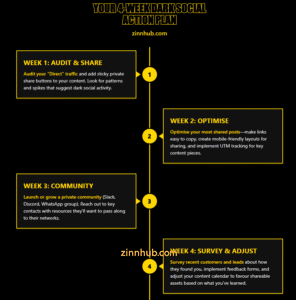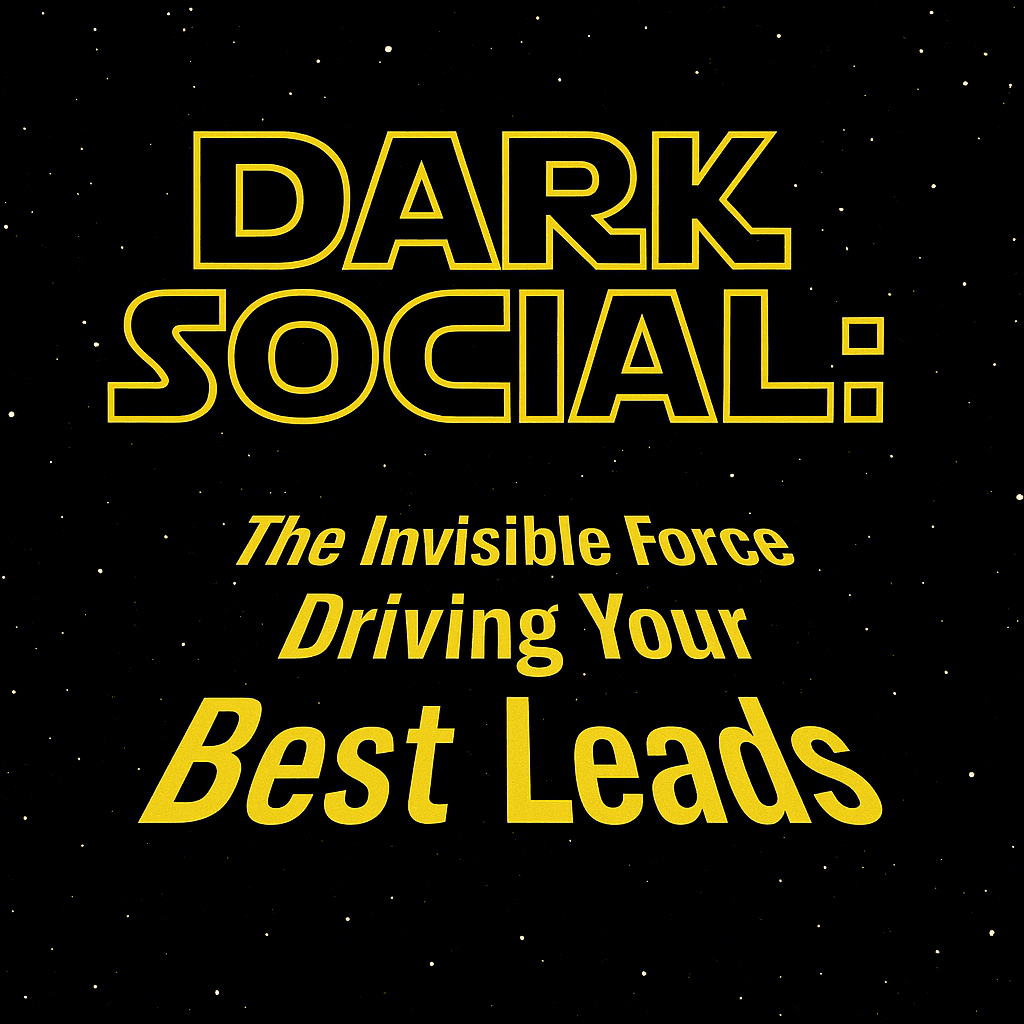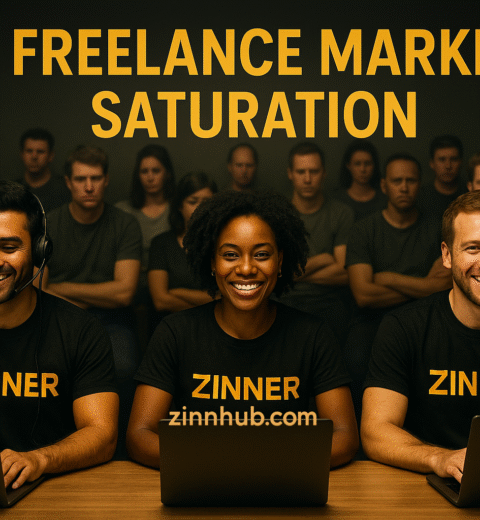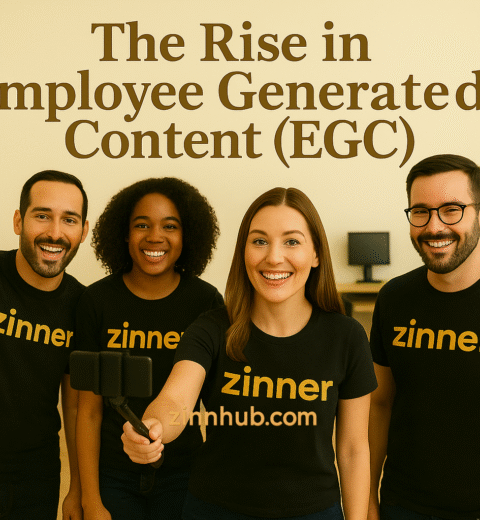Table of Contents
- The Analytics Mystery: Where’s All This Traffic Coming From?
- What Exactly Is Dark Social?
- Who Uses Dark Social? (Demographics and Behaviour)
- Real-Life Dark Social: What Does It Look Like?
- Why Should You Care About Dark Social?
- Why Analytics Miss the Mark (The Technical Bit)
- The Dark Social Advantage: Why Private Beats Public
- The Practical Guide: How to Leverage Dark Social
- Advanced Dark Social Detection
- Zinn Hub Specific Strategies
- FAQs About Dark Social
- The Business Impact You Need to Understand
- Your 4-Week Dark Social Action Plan
- The Future of Dark Social
- The Dark Social Summary
- Not Sure How to Track or Optimise Your Dark Social Analytics?
Ever wondered why your best content seems to get traffic from “nowhere”? You’re not alone. Welcome to the era of dark social – and it’s about time you made it work for you.
The Analytics Mystery: Where’s All This Traffic Coming From?
Picture this: you hit “publish” on a genuinely useful blog post—let’s say it’s about remote work productivity or top digital marketing hacks. Within hours, you notice a steady stream of visitors rolling in. But when you log into Google Analytics, 60% of that traffic is labelled “Direct”. No referrer. No social shares. No real explanation.
Your content is spreading. You can see it. But you’re flying blind.
The problem isn’t an error with your tracking—it’s dark social in action. And in 2025, it’s become the dominant way that valuable content and recommendations spread online. A 2016 study by RadiumOne estimated that up to 84% of content sharing occurs through ‘dark social’ channels—private spaces like messaging apps and emails that are challenging to track with standard analytics.
What Exactly Is Dark Social?
Despite the mysterious name, dark social isn’t sinister. The term was coined by Alexis Madrigal from The Atlantic back in 2012, but the phenomenon has exploded since then. It refers to all the sharing, conversations, and visits about your brand or content that happen in private spaces—outside the reach of traditional analytics.
Think of it as the marketing equivalent of dark matter: you can’t see it directly, but you know it exists because you see the effects.
Where does dark social actually happen?
- Private messaging apps: WhatsApp (over 2 billion users), Telegram, Signal, Facebook Messenger, iMessage, and SMS—billions of links are swapped daily, far from public view.
- Professional DMs: LinkedIn and X/Twitter DMs, Discord servers, Slack channels, and Microsoft Teams chats where colleagues share resources.
- Email forwards: That classic “FWD: You need to see this” can drive more traffic than a viral social post—and it’s completely invisible to your analytics.
- Closed groups & forums: Private Facebook groups, industry forums, mastermind circles, and professional communities.
- Word of mouth: Sometimes dark social is as simple as someone sharing your brand on a phone call or in a face-to-face chat—offline, but with a huge online impact.
Who Uses Dark Social? (Demographics and Behaviour)
Dark social isn’t just for techies or the super-privacy-conscious—it’s for everyone. Research shows:
- Gen Z and Millennials: These generations live in private DMs and group chats, often sharing content with friends in WhatsApp, Snapchat, or Discord rather than public posts.
- Gen X and Boomers: Increasingly, older generations use private groups (think: Facebook Groups or closed WhatsApp chats) to share recommendations, resources, or family updates.
- B2B and Professionals: Many business recommendations and resource shares happen in workplace tools like Slack, Microsoft Teams, and LinkedIn DMs. In fact, in the world of B2B marketing, this private sharing forms what’s now called the “dark funnel”—a term popularised by Chris Walker (Refine Labs)—where buyers make decisions out of sight of marketers and attribution tools.
No matter your target audience, they are almost certainly using dark social in some form.
difference?
DARK SOCIAL
Dark Social refers to untraceable interaction on social media.
DARK FUNNEL
Dark Funnel is more intent-focused and refers to untraceable potential buyers.
Real-Life Dark Social: What Does It Look Like?
Let’s make this practical with some scenarios you’ve probably experienced:
1. The B2B Share
Sarah, a marketing manager, discovers your “Content Calendar Template.” Rather than tweet about it (where her competitors might see), she shares it in her team’s Slack, emails it to marketing contacts, drops it in a private Facebook group, and DMs it to a few industry friends on LinkedIn.
Result: Dozens of visits, zero public trace, and her colleagues think she’s brilliant for finding such a useful resource.
2. The Group Chat Generation
Younger readers might share a screenshot of your post in a group chat, drop the link in a private Discord server, mention it in a friends-only Instagram Story, or copy-paste your best tips into a WhatsApp group.
3. The Professional Recommendation
A consultant bookmarks your report and shares it directly with clients during Zoom calls, sends it via encrypted email, references it in closed presentations, and forwards it to their professional network. Every share is valuable—but you’ll never see the trail in your analytics.
4. Human-Verified Attribution (Real Example)
It’s not just a theory. Many companies now track lead sources by simply asking, “Where did you hear about us?” In our own case, we’ve seen deals attributed to a “Zinner” recommendation via a private Slack message, or feedback like:
“Found you from a LinkedIn DM, then saw your blog shared in our agency WhatsApp group.”
That’s dark social in action—human-verified and genuinely powerful.
Why Should You Care About Dark Social?
Here’s where it gets interesting:
- It’s where most sharing happens: Studies consistently show that 65–84% of content sharing now takes place via dark social. On mobile devices, that number can be even higher—and mobile usage isn’t exactly declining.
- It drives action and trust: Private recommendations convert at four times the rate of public social shares. When someone you trust sends you something directly, you’re far more likely to engage with it properly rather than just scrolling past.
- It’s algorithm-proof: Private sharing means no battling with the Facebook or Instagram feed algorithm—your content lands right where it’s needed, when the recipient is actually paying attention.
- Higher intent, better leads: People share privately when something is truly relevant and valuable. These aren’t vanity metrics—these are genuine recommendations between trusted contacts.
- Referral marketing, upgraded: Every dark social share is word-of-mouth marketing at digital scale—hugely valuable, even if you can’t see every instance.
Why Analytics Miss the Mark (The Technical Bit)
Most website analytics rely on “referrer” information to know where traffic comes from. When someone clicks a link on Facebook, your analytics can trace that back to Facebook. Simple.
But when someone clicks a link in a private WhatsApp message or encrypted app, that referrer information isn’t passed on—there’s no digital fingerprint. The result? All this activity shows up as “Direct” traffic, making it look like people are typing in your URL from memory (spoiler: they’re probably not).
Privacy Matters:
Layer on privacy-first changes like GDPR, iOS tracking limits, encrypted messaging becoming standard, and the rise of ad blockers, and it’s no surprise dark social is on the rise. Users expect privacy and control over their data—something marketers need to respect and embrace. Building trust with your audience is more important than squeezing out one more data point.
The Dark Social Advantage: Why Private Beats Public
- No algorithm gatekeepers: Every message lands directly in the recipient’s inbox or chat—no feed algorithm deciding whether your content is “worthy” of being seen.
- Timeless sharing: Private links don’t get buried in the feed after a few hours—they’re referenced, bookmarked, saved in pinned messages, and passed around for weeks or even months.
- Personal endorsement: When someone shares privately, they’re putting their reputation behind your content. That’s powerful social proof that money can’t buy.
- Quality over quantity: You might get fewer total views, but each view is from someone who was specifically recommended your content by a trusted source.
The Practical Guide: How to Leverage Dark Social
You can’t “track” every private share (nor should you want to—privacy matters), but you can absolutely influence how your content is shared and make the most of dark social’s power.
1. Create Share-Worthy Content
Think: templates, checklists, insider guides, controversial but thoughtful takes, and resources that people will want to forward to a colleague or save for later. Before publishing, ask yourself: “Would I share this with a mate?”
Content that sparks private conversations:
- Professional insights that colleagues might want to share within their organisations
- Personal stories that feel too intimate for public sharing but perfect for close friends
- Industry news that generates “did you see this?” moments
- Practical resources that solve specific problems
2. Add Share Buttons for Private Channels (And Make Them Sticky)
Don’t just offer Facebook and X. Add WhatsApp, Telegram, Messenger, LinkedIn DM, and even a prominent “Copy Link” button that pre-loads a short, clean link. Consider sticky share buttons (that float alongside your content as readers scroll) in addition to inline ones—this increases the chances people will actually use them.
Pro tip: Keep your share buttons and follow buttons separate, so users aren’t confused.
3. Use Smarter Links and Tracking
- Branded short links: Tools like Bitly, TinyURL, or custom branded shorteners create links that are easy to copy, look tidy in a message, and give you analytics on click-throughs even when shared privately.
- UTM parameters: Create trackable campaigns specifically for dark social, e.g.:
yoursite.com/article?utm_source=dark-social&utm_medium=share&utm_campaign=article-title
Even if someone strips the UTMs when sharing, you’ll catch some data, and it helps you identify patterns.
4. Build Your Own Private Community
Whether it’s a Slack group, Discord server, WhatsApp group, or private newsletter, create spaces where your readers can share and chat about your content outside the noise of social media. These communities become dark social hubs where your content gets shared organically.
Example:
A digital marketing agency might set up a private Slack workspace for their clients, where members can ask questions, share resources, and discuss strategies—often sharing blog articles and templates internally.
5. Ask Directly (The Simple Solution)
When someone signs up, downloads a resource, or makes an enquiry, simply ask: “How did you find us?” You’ll be surprised how often the answer is “A colleague sent me your link,” “Saw it in my team’s WhatsApp,” or “Someone shared it in our Slack channel.”
This direct feedback is often more valuable than any analytics dashboard.
6. Watch for Clues and Patterns
- Sudden spikes in “Direct” traffic after you publish a resource? That’s classic dark social.
- Longer time-on-site from unknown sources? People who arrive via private recommendations tend to be more engaged.
- High-quality leads that don’t match your public channels? They’re probably coming through private recommendations.
- Mobile vs desktop patterns: Mobile devices account for more dark social sharing—if you see heavy mobile direct traffic, that’s often private sharing in action.
7. Try Social Listening Tools
While you can’t listen in on private messages, social listening tools like Brand24, Mention, or even Google Alerts can help you spot trends in public conversations that might be spilling over into private sharing.
Analytics enhancements like Parse.ly, Chartbeat, or even link shorteners with analytics can help you estimate the impact.
Advanced Dark Social Detection
Analytics Deep Dives
Look for these patterns in your data:
- Compare social referral traffic to overall engagement levels—if engagement is high but trackable social shares are low, you’ve got dark social activity.
- Monitor the gap between social shares reported by platforms (Facebook says 50 shares) and actual traffic (you get 500 visitors).
- Track content performance across different time periods—dark social content often has longer “legs”.
Community Engagement
Don’t underestimate the power of brand-run communities. Whether it’s a private Facebook group, a members-only Discord, or a dedicated Slack for your users, these are gold mines for dark social engagement. You set the tone, build loyalty, and learn directly from your best customers.
Zinn Hub Specific Strategies
- For freelancers & consultants: Make case studies, guides, and pricing resources easy to forward. Clients absolutely share these internally—your proposal template might get passed around an entire department before you even know you’re being considered.
- For remote teams: Policy templates, tool reviews, and process guides are gold for sharing in internal comms—design your content for easy download, copy-paste, and internal distribution.
- For marketers: Create campaign templates, reporting frameworks, and exclusive insights that agencies and clients will want to share privately. That “Marketing Strategy Checklist” might end up in a dozen agency Slack channels.
- For B2B businesses: Think about what gets shared in professional settings—industry reports, vendor comparisons, internal presentation templates, and “how we solved this problem” case studies.
FAQs About Dark Social
What is an example of dark social?
Sharing a product link in a WhatsApp group, forwarding an email newsletter, or recommending a tool in a private Slack channel are all classic examples of dark social.
What’s the difference between dark social and the dark web?
Dark social is simply private, untrackable sharing (nothing sinister!), while the dark web is a hidden part of the internet, often associated with illegal activities.
What is the “dark funnel” in B2B marketing?
The “dark funnel” refers to the invisible part of the buyer’s journey where decisions and recommendations happen in private channels, outside your analytics. It’s a hot topic in B2B, especially as described by Chris Walker (Refine Labs).
Can you measure dark social?
Not directly—but you can watch for spikes in direct traffic, longer session times, and ask new leads how they found you.
What’s a dark post?
In some circles, “dark post” refers to paid social ads that are not posted publicly on your feed, but it’s often confused with dark social. Dark social is about private, unpaid sharing.
How do you track dark social?
Use a mix of UTM links, branded shorteners, sticky share buttons, social listening tools, and direct customer feedback. But accept you’ll never see the whole picture—and that’s OK.
The Business Impact You Need to Understand
- Attribution problems: When most of your best traffic is invisible, traditional ROI calculations become meaningless. You might be undervaluing your best-performing content and overinvesting in trackable but less effective channels.
- Undervalued content: Your most shared pieces might look mediocre in analytics because their true reach is hidden in private channels.
- Resource misallocation: Without accurate data, you might pour money into paid social ads while neglecting the content creation that’s actually driving private recommendations.
Your 4-Week Dark Social Action Plan
Week 1: Audit your “Direct” traffic and add sticky private share buttons to your content. Look for patterns and spikes that suggest dark social activity.
Week 2: Optimise your most shared posts—make links easy to copy, create mobile-friendly layouts for sharing, and implement UTM tracking for key content pieces.
Week 3: Launch or grow a private community (Slack, Discord, WhatsApp group). Reach out to key contacts with resources they’ll want to pass along to their networks.
Week 4: Survey recent customers and leads about how they found you, implement feedback forms, and adjust your content calendar to favour shareable assets based on what you’ve learned.

The Future of Dark Social
As privacy becomes increasingly important to users (and regulators), dark social will only continue growing. Messaging apps are expanding their features, making it even easier to share content privately. Meanwhile, regulations like GDPR, iOS privacy changes, and increasing cookie restrictions make traditional tracking more challenging.
The smart move? Stop fighting it and start embracing it. Focus on creating content so valuable that it must be shared—regardless of whether you can track it.
The Dark Social Summary
Dark social isn’t a tracking problem you need to solve—it’s the new reality for digital content, especially in a privacy-first, mobile-first world. The businesses, freelancers, and marketers who succeed are those who build content so valuable that it must be shared—often in places you’ll never see.
Your content is probably already travelling through dark social channels right now. People are copying your URLs into WhatsApp chats, forwarding your articles via email, and dropping your resources into Slack channels. The question isn’t whether you should care about dark social—it’s whether you’re ready to optimise for it.
So next time you write something, ask: “Would I send this to a friend?” If the answer’s yes, you’re already on your way to mastering dark social. The invisible force driving your best leads doesn’t have to remain invisible to your strategy.
Not Sure How to Track or Optimise Your Dark Social Analytics?
If you’re feeling lost when it comes to analytics, dark social, or attribution, don’t worry. You can hire a specialist Zinn Hub freelancer (Zinner) to help you make sense of your data, improve your strategy, and unlock more value from your marketing. 👉 Discover expert Zinners at ZinnHub.com




